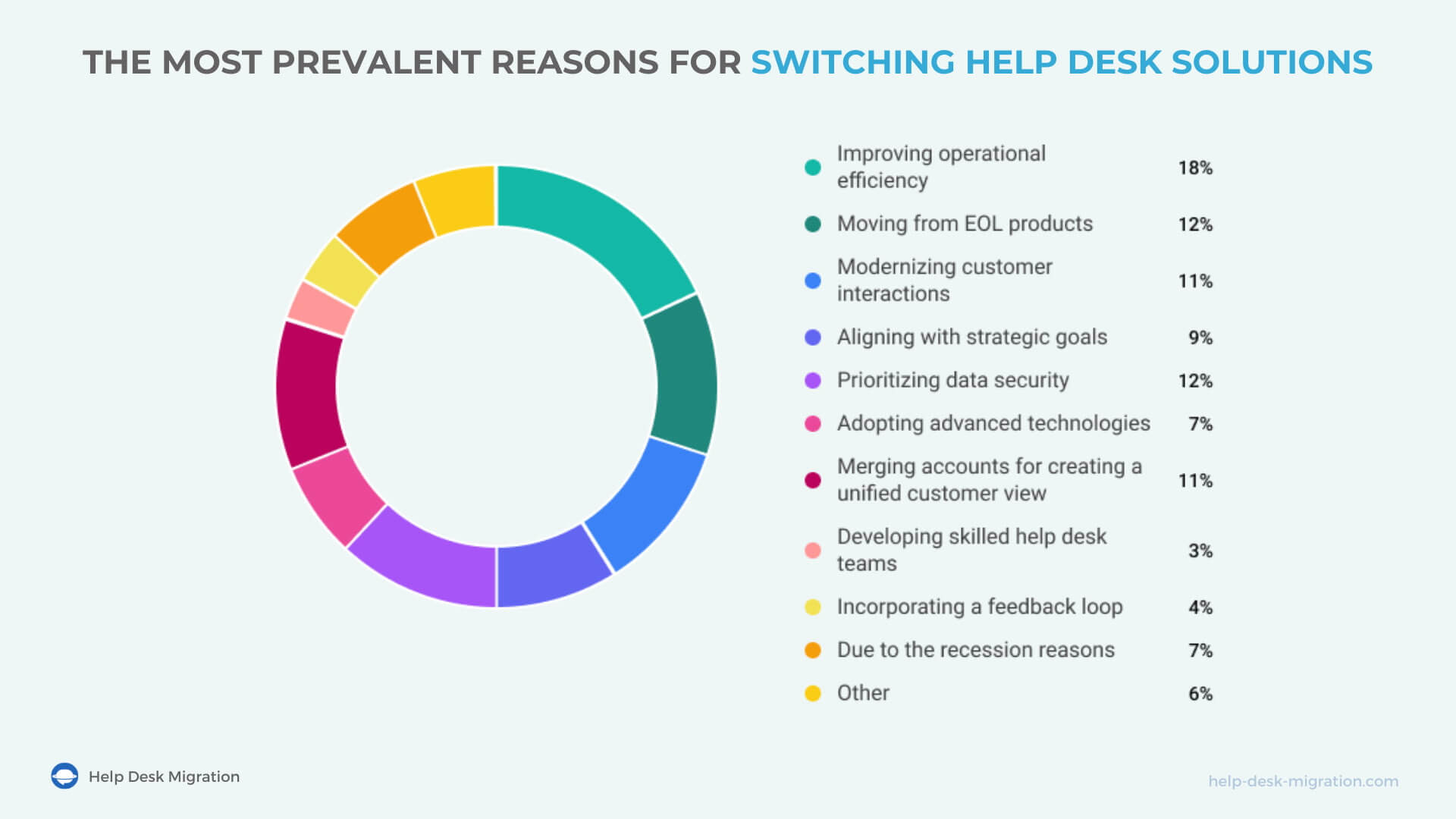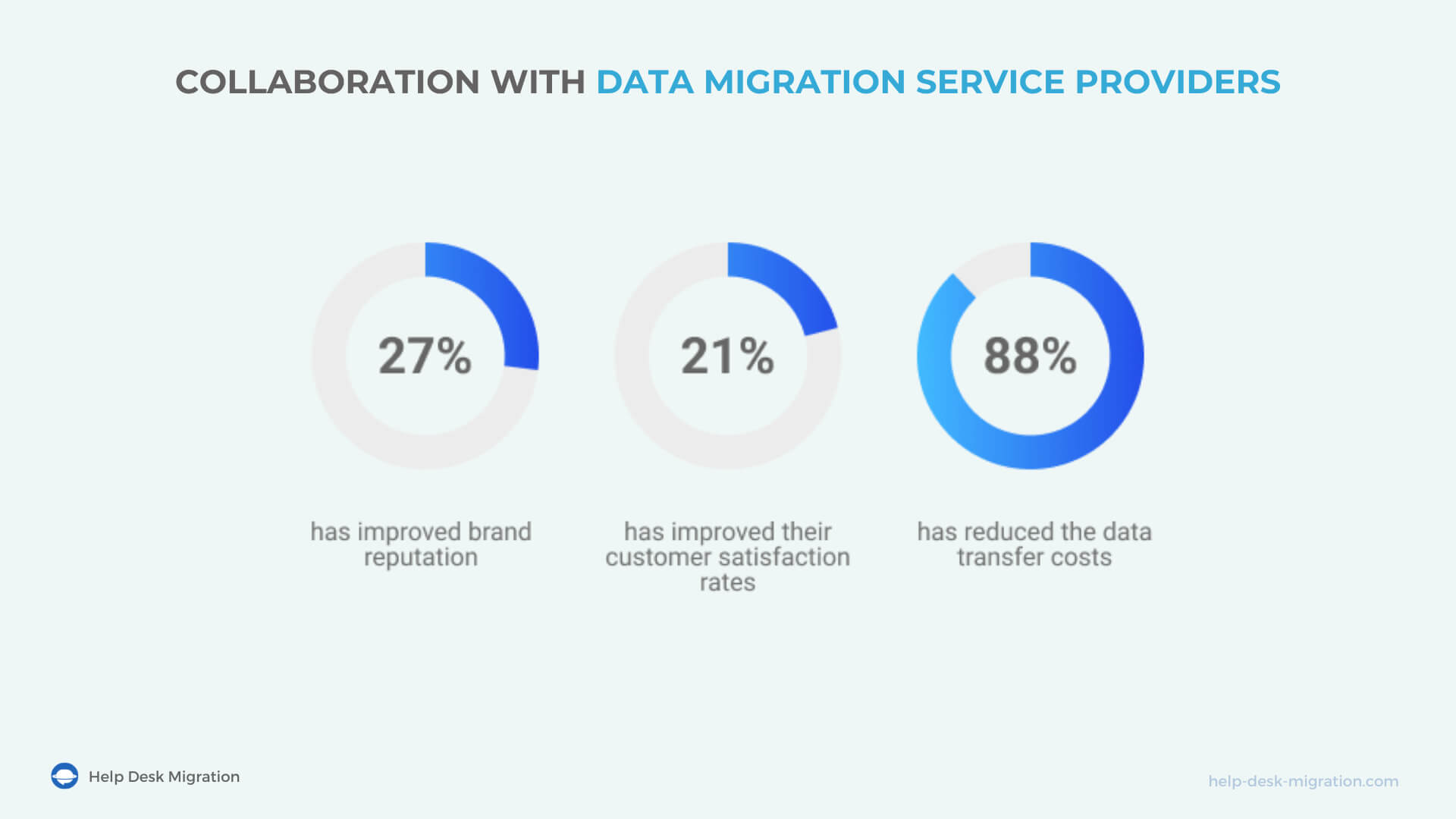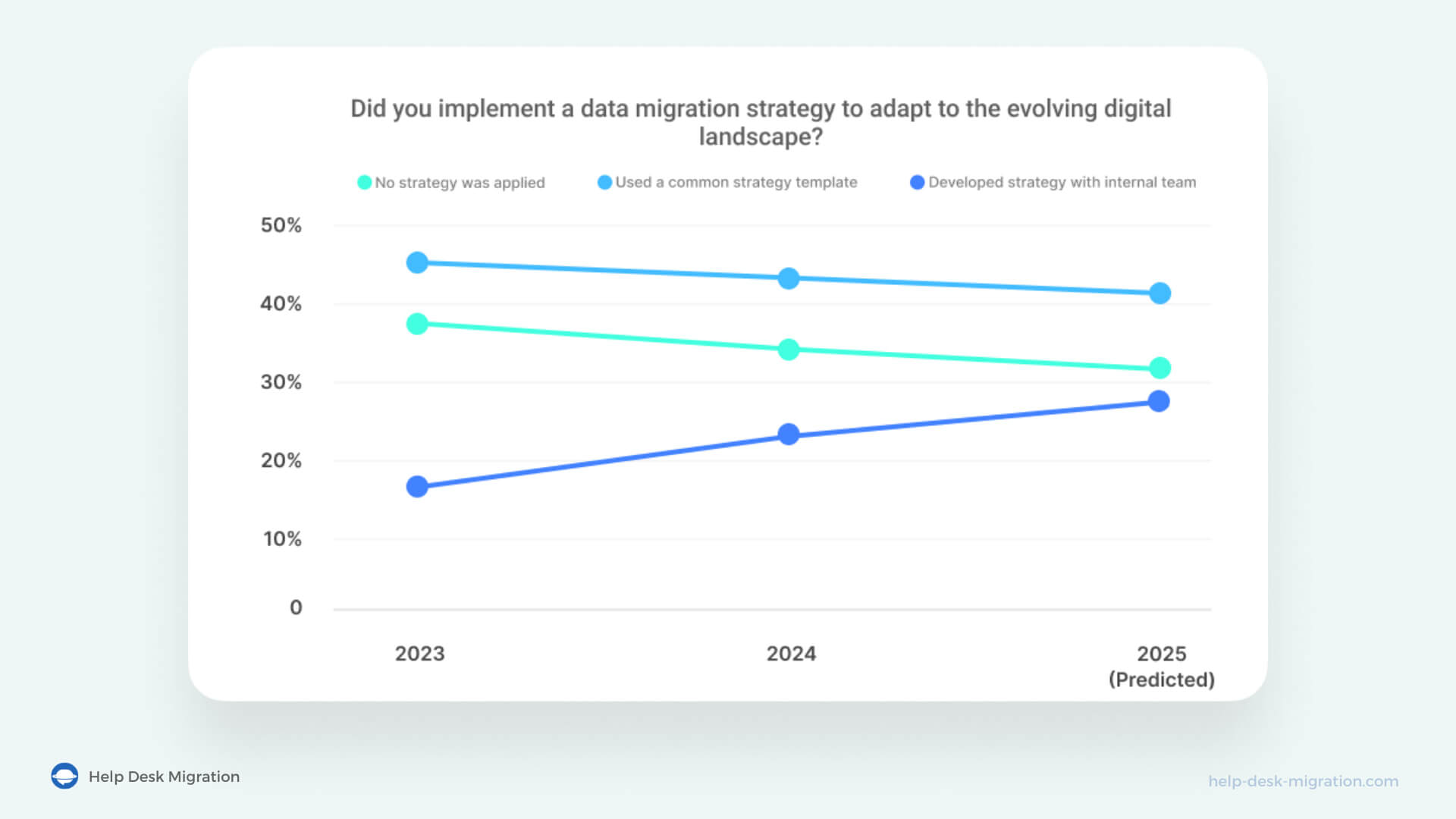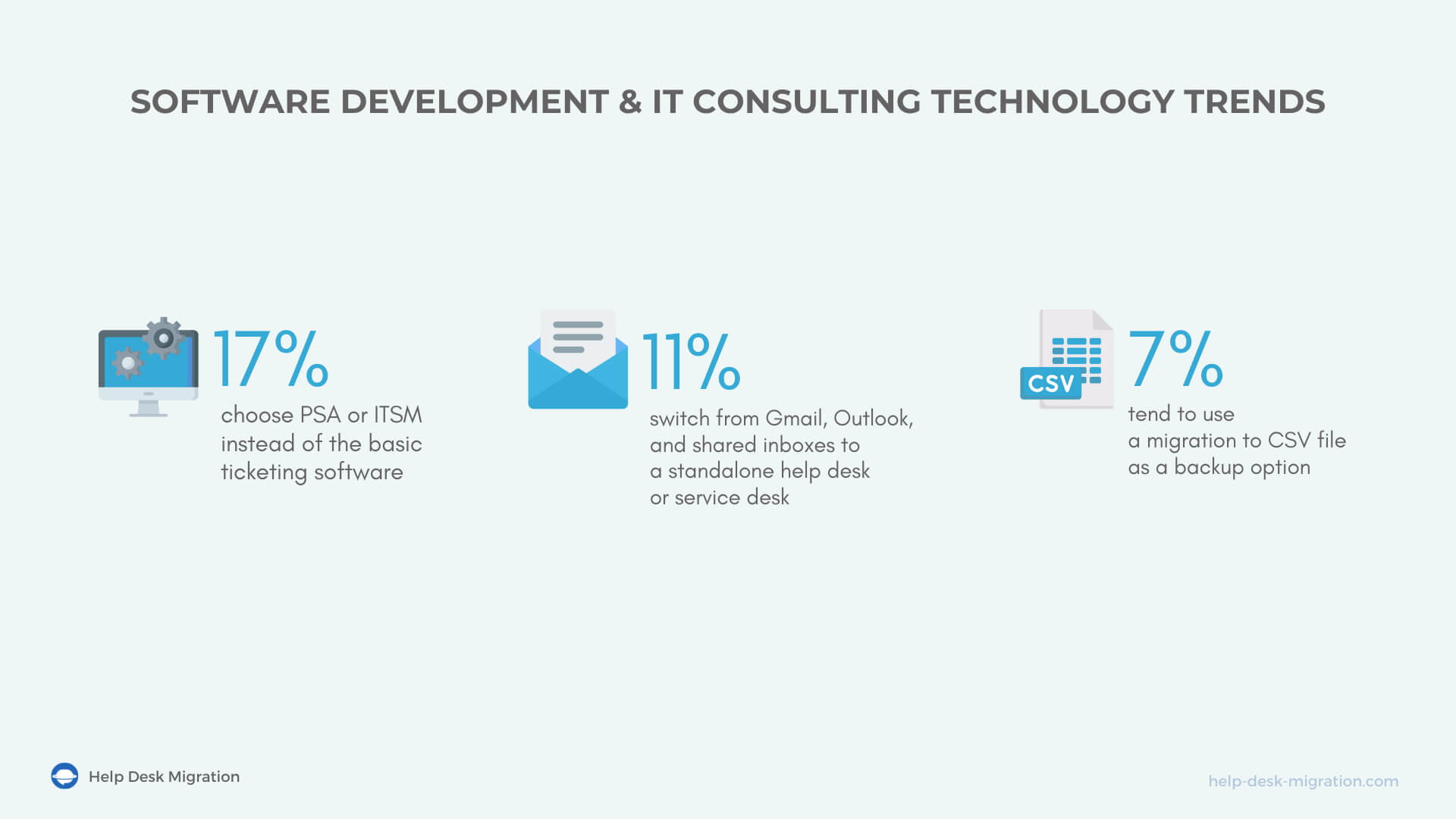A copy-paste is one of the handiest tools in everyone's arsenal. You select the data, press a couple of buttons, and now everything is in the right place. At first glance, data migration has a similar concept, but behind this process lies a lot of challenges and strategies that can affect your data import. So, what is behind successful data migration?
Let's go through data migration strategies and pivotal challenges businesses face during data migration to better understand the cloud data migration process. Additionally, we'll unfold industry insights for data migration and key trends, including the impact of emerging technologies in this area.
Why businesses migrate help desk solutions
Business leaders tend to migrate to help desk platforms for a variety of reasons. Founders and CEOs pursue streamlined operations and strategic expansion. CTOs and CIOs move to more advanced platforms to optimize support operations and data security. Customer support and successful department heads strive to enhance user experience and service quality. Meanwhile, the DevOps teams want to ensure collaborative enhancements and system stability.

Below are the most prevalent reasons for switching help desk and customer support solutions for all audiences, regardless of company size.
- Improving operational efficiency: Business leaders migrate from outdated platforms to advanced help desk platforms compatible with AI-driven features, freeing up their human resources and improving productivity.
- Moving from end-of-lifecycle (EOL) products: A transfer to another platform becomes necessary if the current solution loses routine support or is nearing the EOL stage.
- Modernizing customer interactions: Leaders aim to move from email-only support when companies can no longer handle the ticket volume or accurately track the support agent’s workflows.
- Aligning with strategic goals: Migrating to help desk systems can help meet the company's needs (like custom workflows and omnichannel support), enhance brand image, and improve customer offerings.
- Prioritizing data security: Support platforms complying with data privacy and security regulations reduce the risk of illegal access and leaks.
- Adopting advanced technologies: Help desk systems integrating advanced AI-powered chatbots, collaboration tools, analytics tools, and social media can elevate customer support service.
- Merging accounts for creating a unified customer view: Organizations look for help desk systems that provide a cohesive view of customer interactions across all channels. As well as consolidating two or more help desk accounts for a concise view of customer interaction history.
- Developing skilled help desk teams: Platforms with comprehensive training modules and knowledge bases can assist in elevating the skill levels of support teams.
- Incorporating a feedback loop: Migrating to help desk platforms with AI-enhanced analytics can help identify recurring issues, clients’ key pains, and workload bottlenecks.
- Due to the recession reasons: The topic of recession is taking center stage, with the conversation shifting from if it happens to when. Businesses now face double trouble—staying afloat in an inflationary climate and also preparing for potentially harder times. Companies have been slashing budgets, leading to widespread cutbacks, and customer service is no exception.
What business & technology trends shaping the future
The current trends in help desk software and data migration highlight significant industry growth, technological advancements, and the evolving nature of customer service. Let’s delve into these trends, emphasizing their impact on business strategies and customer support efficacy.
- Steady market growth. The global help desk software market will grow from about $10 billion in 2021 to $26.8 billion by 2023 at a CAGR of 9.4% (according to the 2022 Future Market Insights report).
- Companies are embracing tech industry innovations for help desk software. Help desk and customer support solutions transcend traditional IT problem-solving. The most successful solutions are workflow automation, proactive monitoring, productivity benefits, and data-driven decision-making.
- Consumer satisfaction is a priority. When choosing help desk software, businesses prioritize consumer satisfaction. Studies show that a “totally satisfied” consumer generates revenue up to 17 times more revenue than a “somewhat dissatisfied” consumer.
- Focus on multichannel help desks. Businesses are increasingly transitioning to automated help desk systems for enhanced multichannel communication. According to our 2023 survey, support across channels leads to a 35% increase in customer satisfaction in post-migration phases.
- Mobile-friendly optimization. Organizations are prioritizing mobile support accessibility in customer support services. Migrating to mobile-friendly versions has shown a substantial 40% increase in user satisfaction.
- Collaboration with data migration service providers. Collaboration with dedicated help desk migration providers tends to improve brand reputation by 27%, customer satisfaction by 21%, and reduce up to 88% of the transfer costs.

- Adoption of cloud-based solutions continues. The adoption of flexible cloud-based migrating methods has grown by 25% since 2024. Amazon Web Services (AWS) holds a dominant 40% share of the cloud service market for data migration. However, a trend toward a hybrid cloud approach is also noticeable, providing businesses with flexible migration options.
- Cost-efficiency through automation. Automating help desk operations reduces, and sometimes even eliminates, the cost of handling IT support tickets. Businesses report a 30% improvement in migration speed and accuracy with AI-based automated tools.
63% of our returning customers say they get smoother onboarding after moving their customer service data with Help Desk Migration
- AI and machine learning for proactive incident management. Implementing machine learning algorithms for proactive incident management solutions in data migration processes has led to a 25% reduction in critical incidents.
- Analytics and monitoring during migration. The use of AI-powered predictive analytics in data migration decreased unexpected data anomalies by 30%, while real-time monitoring solutions have contributed to a 22% reduction in system downtime during migrations.
- Investment in IT training initiatives. Comprehensive training programs for help desk tools result in 35% fewer migration-related errors. Moreover, ongoing help desk training improved the IT workforce's adaptability to new technologies by 40%.
Did you implement a data migration strategy to adapt to the evolving digital landscape?
| Year | No strategy was applied | Used a common strategy template | Developed strategy with internal team |
|
2023 |
38% |
45% |
17% |
|
2024 |
35% |
42% |
23% |
|
2025 (predicted) |
32% |
40% |
28% |

What are the top data migration trends across industries
Data migration trends indicate that organizations prefer help desk platforms that complement their existing workflows. We’ve uncovered the key insights for several industries. Let's discuss them.
Software Development & IT Consulting Technology Trends
- Self-service functionality: Firms are implementing self-service options, such as AI-powered chatbots and FAQs, to reduce support team workloads and improve customer satisfaction.
- Scalable storage solutions: Even small and mid-sized business IT companies are seeking platforms capable of processing extensive data volumes without efficiency problems.

- Management and collaboration tools: Organizations prefer service desk systems, PSA or ITSM, that facilitate task management, file sharing, and communication for efficient IT consulting strategy generation.
- Robust data security technologies: Technical companies are migrating to platforms with sophisticated verification mechanisms, encrypted communications, and role-based access control.
Education Technology Trends
- Student-faculty interaction: Educational institutions are moving to systems that facilitate assignment submissions.
- Adhering to privacy standards: The focus is on platforms that ensure data security and compliance with educational privacy laws.
- Learning management system integration: E-learning sites want integration with existing educational tools, as well as video and audio streaming features.
Did you leverage artificial intelligence and automation technologies in your customer service?
| 2023 | 2024 | 2025 (predicted) | 2026 (predicted) | |
|
Yes, we use an AI-based chatbot |
21% |
24% |
27% |
30% |
|
Yes, we use chatbot and automation of workflow |
13% |
19% |
22% |
25% |
|
Use the built-in AI services of the help desk/service desk |
26% |
29% |
32% |
35% |
|
Plan to adapt the AI-based chatbot |
18% |
12% |
13% |
15% |
|
Not sure |
22% |
16% |
6% |
5% |
Real Estate Technology Trends
- Client relationship management: Real estate businesses are adopting ITSM systems to manage their IT services efficiently and for better service delivery.
- Document management tools: Organizations prefer platforms with document management and e-signature capabilities to handle legal documents.
- Safeguarding client information: The emphasis is on help desk platforms that provide secure and confidential handling of sensitive client information.
25% has a rise in demand for cloud-based service desk solutions, emphasizing the need for accessible and flexible support systems due to the remote work trends
Healthcare Technology Trends
- HIPAA-compliant systems: Healthcare providers require help desk platforms that ensure patient data confidentiality and compliance with healthcare laws.
- Order management and tracking: Companies want platforms that track details on billing, medical recalls, and system updates and are connected to IoT devices.
- Efficient patient record management: The most popular healthcare IT solutions for customer support allow non-technical staff to access and update patient records.
eCommerce and Retail Technology Trends
- High-volume customer interaction: eCommerce and retail businesses are adopting systems capable of managing large-scale customer inquiries during peak times.
- Order management: Retailers focus on solutions that integrate software for order management and tracking.
- Customer analytics: Organizations require customer segmentation functionality to tailor support and, when possible, follow up with targeted marketing.
- Secure payment processing: Help desk and customer support platforms must work with reliable payment processing solutions.
What was your success rate in running your data migration project?
| Business Industry or Market Sector | 2023 | 2024 | 2025 (predicted) | 2026 (predicted) |
|
Business Consulting |
72% |
75% |
78% |
80% |
|
eCommerce |
70% |
75% |
80% |
83% |
|
Educational Services |
65% |
68% |
70% |
72% |
|
Financial Services |
72% |
75% |
77% |
80% |
|
75% |
78% |
80% |
82% |
|
|
Healthcare |
70% |
82% |
85% |
87% |
|
Manufacturing |
68% |
70% |
72% |
75% |
|
Marketing Services |
75% |
78% |
82% |
85% |
|
72% |
77% |
81% |
84% |
|
|
68% |
70% |
72% |
75% |
|
|
Real Estate |
65% |
68% |
70% |
73% |
|
Software and IT |
78% |
82% |
86% |
88% |
|
Telecom |
68% |
70% |
74% |
77% |
What are the hidden data migration challenges
Data migration presents a spectrum of considerations and challenges, ranging from data integrity and compatibility to compliance and data privacy. These data migration challenges can lead to unexpected downtime, time-consuming reworks, and extra costs. We’re going to outline the most common problems businesses face in all industries.
Dealing with business downtime
Help desk systems are often unavailable during data migration to avoid data issues. Opening tickets or updating the knowledge base during migration can cause data loss, duplication, or inconsistencies. For example, your migration might require pausing operations or customer support, leading to lost revenue.
Any migration disruptions, incorrect data field mapping are just as harmful. They require extra customizations, re-mapping data, or may necessitate re-migration. To mitigate such issues, we offer an unlimited testing Demo and re-migration of completed Full Migration within 5 or 10 days (depending on the selected support package) customers take advantage of these features.
Our 2024 survey found that 37% of businesses minimized disruptions using our options to handle that aspect of data migration—Delta migration, Interval migration, and scheduling the start of data migration (i.e., get started in the less loaded time for your support service).
Those who implemented Delta migration into their migration strategies transferred data successfully. Moreover, businesses improved their post-migration continuity by 23% through effective migration initiatives.
Accelerating help desk migration
A fast data migration reduces business downtime, subscription overpayment for software, and the time IT staff spend overseeing the process—if you run data migration employing your internal team. However, the amount of data to migrate, source and target systems, API and its limitations have a direct impact on the speed of organizations’ data migration.
While you can impact the amount of data by filtering or by skipping attachments, the chosen platforms’ specifications can’t be changed, yet the API limits can be adjusted—you need to request that from the help desk or service desk vendors.
Either way, the automated Help Desk Migration service transfers data faster compared to other services. 48% of businesses that Migration Wizard estimates and moves data faster 4 times compared to some other options on the market.
Managing data migration costs
Help desk migration expenses depend on data volume, transfer method, the source and target platforms, and the potential downtime during the migration. Costs rise if data requires customizations to adjust some specific data or data fields with new systems.
Help Desk Migration service providers helped companies reduce the overall implementation timeline by an average of 39%, reducing operational downtime and subsequent losses.
Maintaining the data quality
Data corruption and duplicate records are common during high-volume data transfers. Worse yet, companies usually must identify missing datasets or manually delete unnecessary records.
In our 2024 survey, companies reported 15% fewer data loss incidents than in 2024 after implementing risk mitigation measures. For example, companies can negate risks by backing up data beforehand, using test runs on small data subsets to resolve issues before a complete migration, and having a rollback plan in case of failure.
Supporting multilingual knowledge bases
Organizations should provide several languages for support articles, FAQs, and self-service portals. The usage of self-service options and knowledge bases generally increases by 30% after a successful migration. That’s why multilingual support helps serve a global audience and reduce ticket volume.
Additionally, multilingual knowledge bases help the support staff. Companies can supply employees from regions where English is not the majority language with essential support materials and troubleshooting guides in their language. During 2024, 31% of our customers used the content translation migration option.
Ensuring data privacy and compliance
Help desk systems store personally identifiable information (PII) from customers. Data protection regulations further complicate data handling. Because of this, some businesses encounter data privacy challenges during migration, and fail to meet compliance standards.
Inadequate security during migration can expose sensitive data, risking breaches that could leak this private data, leading to financial and reputational losses. It's necessary to implement stringent security measures and data governance policies.
With the Help Desk Migration, customers get their data secured as the migration tool doesn’t change their data but simply replicates it. And the customers control who can access their migration projects. The security policy complies with the industry standards and keeps improving.
What are the proven data migration strategies
Businesses that invest in strategic data migrations have a 29% ROI after migrations. Additionally, such strategic approaches have led to a 14% improvement in first-contact resolution rates within help desk systems, directly impacting customer satisfaction and service effectiveness.
The key types of data migration strategies for help desks include:
- The Big Bang approach. This method involves transferring all data from the source to the target in a single, comprehensive operation. It's characterized by its immediacy and doesn’t require downtime during the migration.
- The Trickle approach. In this approach, the migration is segmented into smaller, manageable sub-migrations. Each segment has defined scopes, deadlines, and objectives, minimizing disruptions and allowing for more focus on the business processes. Yet, it comes with the downside of data inconsistency and duplicates on the target after finishing all the migration projects.
- The Continuous (zero-downtime) approach. This method involves replicating data from the source to the target migration and, after completion, running a Delta migration. So you remain operational during the migration, and during the Delta migration, the Migration Wizard transfers only updated or new records from the source platform. It’s a fast and secure way that deprives you of downtime but keeps your data consistent.
Comprehensive preparation and planning are vital in identifying the most suitable migration approach for a particular organization.
Bottom line
Data migration is a complex process that requires careful planning, implementation of the most suitable migration approach, and awareness of potential challenges. A well-structured data migration strategy increases service effectiveness, customer satisfaction, and long-term ROI.
When companies understand the specifics of migration challenges and use automated migration software like Help Desk Migration, they can minimize disruption and speed up data transfer processes. Feel free to test our migration tool in a free trial today and discover what sets us apart.



